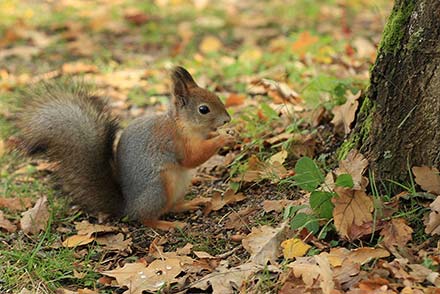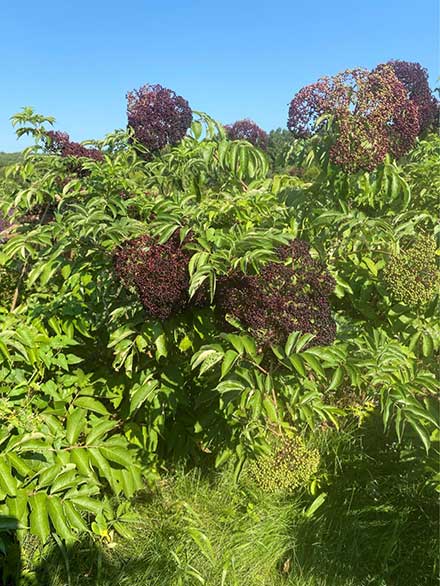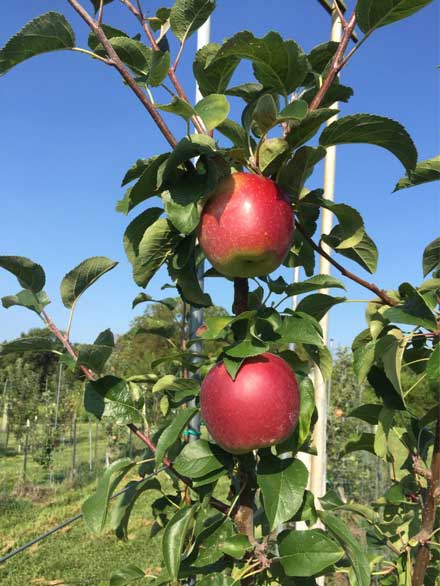Although there are many herbaceous plants that can be planted annually, the establishment of fruit or nut-bearing species in the landscape provides a long-term food source that enriches the diet and provides protective cover for wildlife. The tree or shrub species, their location, as well as the size and shape of the planting will have an impact on wildlife. Many of these plants will fruit for decades and most native species require little management after the first few years of establishment. This guide will provide information on important considerations for successfully establishing and managing trees and shrubs for wildlife benefits.
Site selection

Selecting the proper location and plant species adapted to the site is key to the successful establishment of trees and shrubs. Fine-textured clay soils retain moisture longer than course sandy types, which tend to drain quicker and become dry. Pecan and shellbark hickory trees tolerate short-term flooding, whereas peach is intolerant of wet soil. Also, calcareous soils often have a pH above 7.0, which can induce iron chlorosis in some species such as pin oak. Before planting, a soil test should be conducted and results can be used to determine pH and the fertility of the site. For more information on collecting and submitting soil samples, visit the MU Extension Soil and Plant Testing website.
Plant selection
As a general rule, establishing a diversity of tree and shrub species will increase the types of food and cover that are available for wildlife at different times of the year. Tree plantings with shrub borders maximize the availability of habitat and provide greater benefits for wildlife. A mixture of species with multiple plant heights also attract a greater diversity of wildlife than monocultures.
Several fruit and nut trees either require cross-pollination of flowers to produce a crop or will bear a much heavier crop when a pollinizer is used. Thus, cross-pollination is recommended for American hazelnut, American persimmon, apple, black walnut, blueberry, Chinese chestnut, crabapple, elderberry, European pear, pawpaw, and pecan. For successful cross pollination, two different plant cultivars of the same species that bloom at the same time are planted. In other cases, specific cultivars of crabapple, European pear, and American persimmon have been developed specifically for bearing a fruit crop without the need for an additional cultivar for pollination.
Many of the oak trees provide wildlife with a rich food source of acorns (Figure 1). These trees are classified into white or red categories. Some of the white oak types include bur, chinkapin, overcup, and swamp white. When these trees attain sufficient age, they produce acorns annually. In contrast, trees in the red oak group (northern red, pin, Shumard, willow) initiate acorns every year that require two years to mature. In some years, late-spring frosts can kill oak flowers. However, if both types are planted, acorns initiated the previous year on trees of the red oak group will still mature even though new flowers on white and red oaks are injured by cold temperatures. Also, oaks tend to bear acorns erratically with a heavy crop in one out of three or four years.
Pest resistance is another important consideration when selecting plant material. Choose disease-resistant cultivars when available. Bacterial diseases, such are fire blight, are generally difficult to control and often kill non-resistant apple and pear cultivars.
Grafted vs. seedling trees
Another important consideration is the type of nursery stock planted. Several of the native plants are inexpensively produced from seed. When acorns are planted, squirrels will often eat the remnants of the seed attached to an emerging seedling and kill the plant. Thus, wire screening or other protective measures may be necessary to establish oaks from acorns. For oaks and other species, trees are relatively inexpensive to purchase as bare-root plants. A variety of seedling trees can be purchased online from The George O. White State Forest Nursery near Licking, Missouri, from September 1 through April 15. Because these plants are sold as small seedlings, it will take several years for trees reach a mature size and begin bearing acorns.

Another option is to purchase plant material that has been propagated by air root pruning. Under this method, plants are grown in open containers, which causes the developing tap-root or other young roots to cease growth when they grow out of the potting medium at the bottom of the container, resulting in a highly-branched, well-developed root system. Perennial plants propagated by air-pruning have the added benefit of coming into bearing at a younger age than conventionally-rooted plants. Some Missouri nurseries advertise these air-root-pruned plants as RPM (root pruning method) or EZ Start trees.
Fruit and nut cultivars are usually clonally-propagated to maintain the characteristics of the mother tree. Additionally, fruit and nut cultivars are grafted onto rootstocks to bring the tree into bearing at an earlier age than a seedling. Dwarfing rootstocks induce bearing at an earlier age than semi-dwarfing trees. However, dwarf trees require higher maintenance and generally have a shorter life-span than semi-dwarf trees. Grafted trees are more expensive to purchase than seedlings, but this plant material has been selected for superior characteristics, including high productivity of fruit or nuts. Cost share programs to improve wildlife corridors or habitats on existing crop land are available from USDA, state, and private sources. Information on these programs is available on the Missouri NCRS webpage.
Table 1 lists some of the trees and shrubs recommended for planting in Missouri as a food source or for cover for a selected group of wildlife species. This list is not all inclusive, but a representative sample of perennial trees and shrubs that provide food and cover for wildlife (Figure 2). Specific cultivars are listed for superior characteristics, such as site adaptability, productivity, pollination requirement, or pest resistance. Where specific cultivars are not listed, recommendations may be found at University of Missouri Extension or MU Center for Agroforestry websites.
Table 1. Fruit-bearing trees and shrubs recommended for planting in Missouri to attract specific types of wildlife.
| Plant (Genus species) | Exposure | Soil/site conditionsz | Growth habit | Plant ht.(ft) | Plant width (ft) | Fruiting season | Type of wildlifey |
|---|---|---|---|---|---|---|---|
| Apple, disease resistant (Malus domestica) | FS | well-drained | tree | 10-30 | 15-20 | Aug-Oct | D, F, R |
| Blackberry, ‘Ouachita’ (Rubus spp.) | FS | well-drained | canes | 5-6 | 3-4 | June-July | D, Q, R, T |
| Cherry, black (Prunus serotina) | FS-PS | adaptable to many soils | tree | 40-50 | 30-40 | Aug | GR, T |
| Blueberry, highbush (Vaccinium corymbosum) |
FS | moist, well-drained, acidic, pH 4.8-5.2 |
shrub | 5-8 | 3-4 | June-July | D, GR, Q, R, T |
| Chinese chestnut (Castanea mollissima) | FS | well-drained | tree | 30-40 | 20-40 | Sept | D, DU, G, GR, S, T |
| Crabapple, ‘Prairiefire’x (Malus sp.) | FS | well-drained | tree | 15-20 | 15-20 | Aug-Sept | D, F, R |
| Dogwood, flowering (Cornus florida) | PS | moist, well-drained, acidic | tree | 15-30 | 15-30 | Aug-Nov | Q, T, GR |
| Dogwood, gray (Cornus racemosa) |
FS-PS | adaptable to many soils | shrub/suckering | 10-15 | 8-10 | July-Oct | GR, P, T, Q |
| Dogwood, red osier (Cornus sericea) |
FS | adaptable to many soils | shrub/thicket | 6-9 | 7-10 | Sept-Oct | D, GR, Q, T |
| Dogwood, roughleaf (Cornus drummondii) |
FS | well-drained to slight flooding | shrub/small tree | 6-15 | 6-15 | Aug-Oct | D, GR, P, Q, T |
| Elderberry, American (Sambucus nigra subsp. canadensis) |
FS | moist, well-drained | shrub | 4-8 | 4-8 | Aug-Sept | D, DO, P, Q, R, T |
| Hazelnut, American (Corylus americana) |
FS | moist, well-drained | shrub/thicket | 10-16 | 8-13 | Sept | D, F, GR, P, Q, S, T |
| Hawthorn, green (Crataegus viridis) | FS-PS | well-drained drought-tolerant | tree | 25-30 | 25-35 | Sept-Nov | D, GR, Q, T |
| Hawthorn, Washington (Crataegus phaenopyrum) |
FS | well-drained | tree | 20-30 | 25-30 | Sept-Oct | D, GR, Q, T |
| Hickory, mockernut (Carya tomentosa) | FS-PS | well-drained, acidic | tree | 60-80 | 40-60 | Sept-Oct | D, DU, F, R, RC, S, T |
| Hickory, shagbark (Carya ovata) | FS | well-drained | tree | 70-80 | 50-70 | Sept-Oct | D, F, R, RC, S, T |
| Hickory, shellbark (Carya laciniosa) | FS | slight flooding | tree | 60-80 | 40-60 | Sept-Oct | D, F, R, RC, S, T |
| Mulberry, red (Morus rubra) | FS | moist, well-drained | tree | 35-50 | 10-15 | May-June | D, F, RA, S |
| Oak, bur (Quercus macrocarpa) |
FS | adaptative to soil and moisture | tree | 60-80 | 60-80 | Sept-Oct | D, DO, DU, F, G, P, Q, R, RC, S, T |
| Oak, cherrybark (Quercus pagodifolia) |
FS | good for southeast Missouri | tree | 60-110 | 60-90 | Sept-Oct | D, DO, DU, F, G, P, Q, R, RC, S, T |
| Oak, chinkapin (Quercus muehlenbergii) |
FS | good for high pH soils | tree | 40-60 | 50-70 | Sept-Oct | D, DO, DU, F, G, P, Q, R, RC, S, T |
| Oak, overcup (Quercus lyrata) |
FS | adaptive to soil and moisture | tree | 40-60 | 40-60 | Sept-Oct | D, DO, DU, F, G, P, Q, R, RC, S, T |
| Oak, Schuette (Quercus x schuettei) |
FS | adaptive to soil and moisture | tree | 40-50 | 40-50 | Sept-Oct | D, DO, DU, F, G, P, Q, R, RC, S, T |
| Oak, Shumard (Quercus shumardii) |
FS | well-drained | tree | 40-60 | 40-60 | Sept-Oct | D, DO, DU, F, G, P, Q, R, RC, S, T |
| Oak, swamp chestnut (Quercus michauxii) |
FS | well-drained | tree | 40-60 | 30-50 | Sept-Oct | D, DO, DU, F, G, P, Q, R, RC, S, T |
| Oak, swamp white (Quercus bicolor) |
FS | tolerates wet soils | tree | 50-80 | 50-80 | Sept-Oct | D, DO, DU, F, G, P, Q, R, RC, S, T |
| Oak, willow (Quercus phellos) |
FS | tolerates clay soils, acidic | tree | 40-75 | 25-50 | Sept-Oct | D, DO, DU, F, G, P, Q, R, RC, S, T |
| Pawpaw (Asimina triloba) |
FS | moist, well-drained | shrub/small tree | 15-20 | 8-15 | Sept-Oct | D, F, R, RC, S, T |
| Peach, ‘Redhaven’ (Prunus persica) | FS | well-drained | tree | 12-15 | 18-22 | June-July | D, R, RA, S |
| Pear, European ‘Seckel’x (Pyrus communis) | FS | well-drained | tree | 10-25 | 18-20 | Sept | D, R, RC, S |
| Pecan, northern (Carya illinoensis) | FS | well-drained slight flooding | tree | 50-100 | 40-75 | Oct | D, F, RC, S, T |
| Persimmon, American ‘Yates’x (Diospyros virginiana) |
FS | well-drained | tree | 35-60 | 20-35 | Sept-Oct | D, F, Q, RC, S, T |
| Plum, American (Prunus americana) |
FS | drought-tolerant | shrub/small tree | 7-25 | 15-25 | Aug | D, F, GR, Q, RC, S, T |
| Plum, chickasaw (Prunus angustifolia) |
FP-PS | well-drained | shrub/thicket | 4-20 | 4-20 | June-July | D, F, Q, RC, T |
| Plum, European blue (Prunus domestica) | FS | well-drained | tree | 15-20 | 18-20 | Sept | D, R, RC, S, Q |
| Serviceberry, downy (Amelanchier aborea) |
FS-PS | tolerates clay soil | shrub/small tree | 15-25 | 15-25 | June | D, DO, Q, S, T |
| Viburnum, blackhaw (Viburnum prunifolium) | FS | clay/drought tolerant | shrub | 12-15 | 6-12 | Sept-Oct | D, F, GR, Q, R, S, T |
| Witch hazel, American (Hamamelis virginiana) |
FS-PS | tolerates clay soil | shrub/small tree | 6-10 | 8-15 | Nov-Dec | D, GR, P, Q, R, S, T |
| Witch hazel, vernal (Hamamelis vernalis) |
FS-PS | moist, acidic soil | shrub/small tree | 6-10 | 8-15 | Sept-Oct | D, GR, P, R, Q, S, T |
| Z. Key to Site Conditions: FS = full sun, PS = part shade Y. Key to Wildlife: D = white-tailed deer, DO=mourning dove, DU = ducks, G = ruffed grouse, F = fox, P= ring-necked pheasant, Q = bobwhite quail, R = cottontail rabbit, RC = raccoon, S= tree squirrels, T = wild turkey. X. Listed cultivar is self-fruitful and does not require a different cultivar for fruit set. |
|||||||
Early plant care

When soil test results indicate the need for supplemental nutrients, fertilizer should be applied to the site before planting. At planting, dig a hole that is slightly larger the depth and diameter of the root system. Irrigate the plant immediately after planting. For trees that require support, loosely tie the trunk to a stake to prevent tree breakage (Figure 3). Also, provide tree shelters or wire cages around plants to prevent wildlife depredation for at least two to three years until plants become fully established. About a month after planting, apply fertilizer. Contact local University of Missouri Extension Field Specialists for recommended fertilizer application rates for specific plant material. During the growing season, irrigation is usually needed during dry periods. The most frequent cause of tree loss is lack adequate soil moisture.
Additional resources
For additional information on enhancing your property for wildlife, contact your local Extension office. Other related MU Extension publications about specific wildlife habitats are available at the resources listed below.